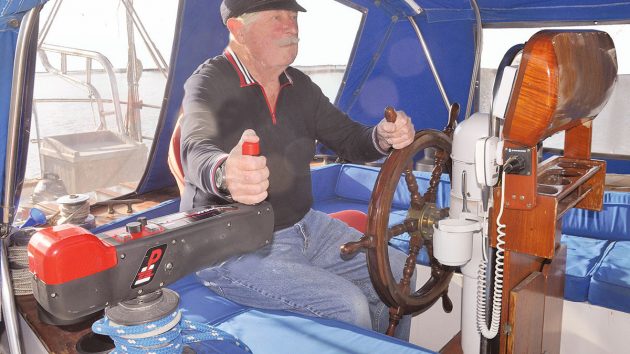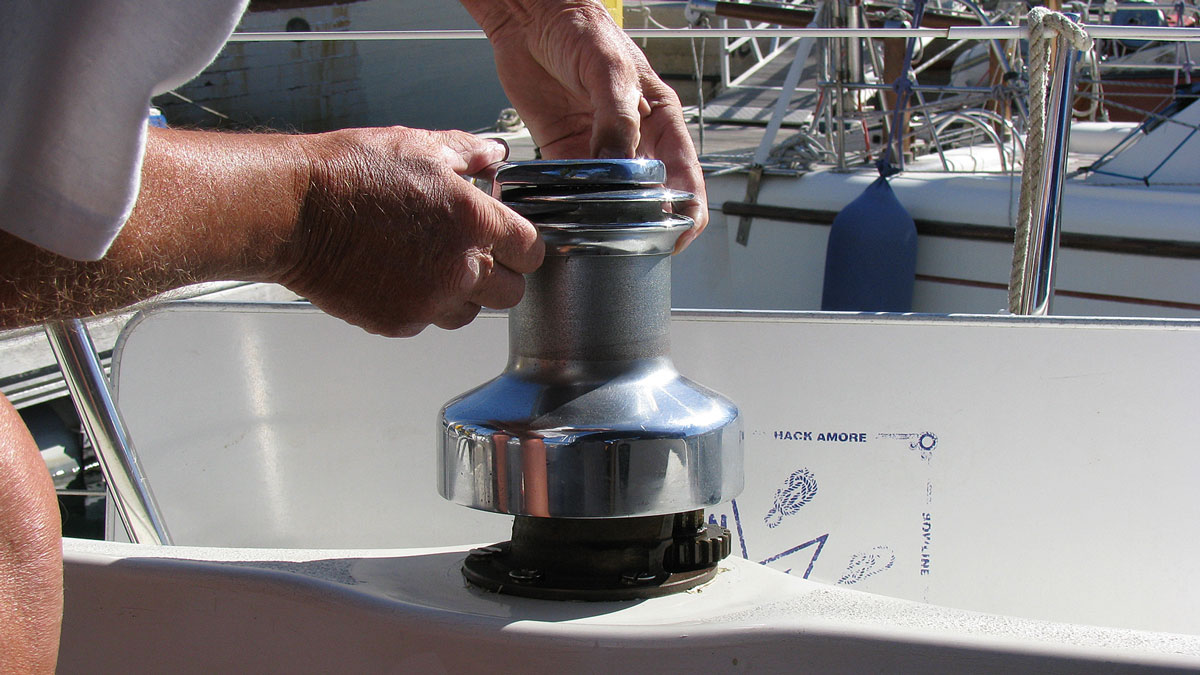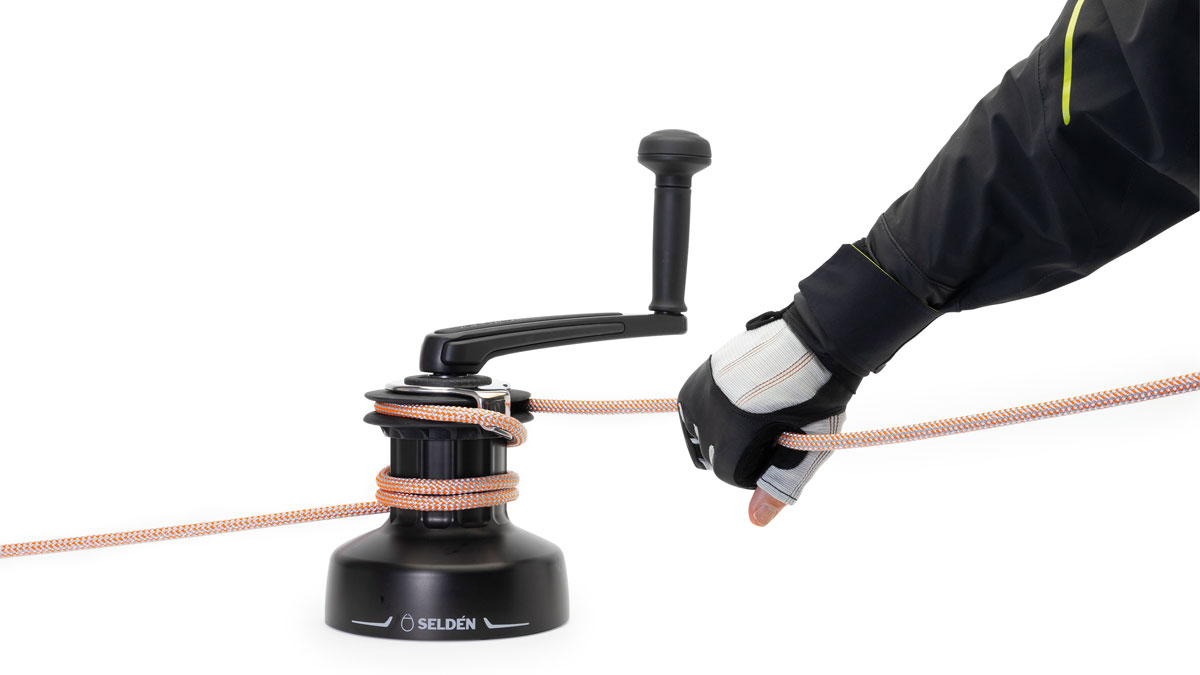Electric winch handles can help crew perform any task on board a yacht, regardless of their strength, size or physical abilities. Roger Hughes looks at how they developed
After I bought my 50ft schooner Britannia in 2010 I decided to fit as many systems as I could afford to make handling the big 20-ton boat easier.
I also converted all five sails to roller-furling and routed 12 control lines back to the centre cockpit to minimise the deck work.
I then fitted self-tailing winches and rope jammers on either side of the companionway to handle all the lines, which we call the rope decks.
This, of course, meant an awful lot of manual winch winding, so after dismissing electric winches due to their horrendous cost, I began to think about how to make an electric winch-winder myself.
The early electric winch handles went under names like Winch-Master, Winch-buddy, and Modea.

Horizontal winches can also be safely wound provided the drive sprocket locks into the winch to prevent it from falling out under load. Credt: Roger Hughes
These were hard-wired devices that needed to be connected to a battery with a cable – a 4m cable in the case of the Modea – which restricted their use outside of a boat’s cockpit.
I ‘invented’ my first electric winch handle in 1977, using a simple right-angle drill adapter on a battery power drill, with an eight-point sprocket in the chuck.
It worked OK, but the battery expired quite quickly and had to be changed several times.
It was also not very powerful and I usually had to finish off the sheets by hand, by taking the drill out of the winch and winding a regular handle.
This meant first cleating off the sheet because my winches were not self-tailing – many shortcomings indeed, but better than nothing.
I then tried a Milwaukee M28 90° cordless drill, but that was the opposite – it was much too powerful!

The right-angled Milwaukee drill certainly did the job, but it was difficult to handle and couldn’t easily be rotated by hand. It has since been superseded by custom-made machines. Credit: Roger Hughes
When using it I had to be very careful to avoid snapping a line or damaging a sail, not to mention having it wrenched out of my hands if something jammed.
This drill is actually designed for construction workers to drill sideways holes in wood frameworks and pass wires through and it was very heavy.
There are now a few other makes of right-angle drills that are smaller and lighter, but I’ve since moved on.
In 2010 the Winchrite (winchrite.com) was exhibited for the first time at the Fort Lauderdale boat show and I bought one for US$510 – they are now about £650 in the UK.
My next device was the French Ewincher2. This is an ergonomic design with a vertical handle more like a manual winch handle, and with interchangeable lithium-ion batteries.

This was my first crude electric winch handle. The drill was not really powerful enough, but it was better than nothing. Credit: Roger Hughes
This was a great leap forward, because when the battery begins to die – always when you’re using it of course – a new one can be inserted without even taking the machine out of the winch.
It also has several other improvements: a locking plate secures the drive sprocket in the winch automatically – very important if someone is being winched up a mast; the turning circle is only 28cm, the same as a regular winch handle, so when the Ewincher2 is turned by hand, (more on this below), it won’t interfere with anything else in the cockpit, like a Bimini strut, which the massive Milwaukee always did.
The Ewincher2 has Bluetooth capability, so the speed can be controlled from an iPhone, and it also shows the battery charge and how much time is left for use.
Designs of these machines continue to pass through an evolutionary process, and I now have the latest device on the electric winch handle market, the Australian-built Powerwincher (powerwincher.com), which is different from the others in a few notable ways: the drive sprocket is located centrally in the machine, so it ‘sits’ securely in a vertical winch with a nice balanced feel.

The Winchrite was the first of the ‘custom-made’ electric winch handles that I bought. It works well but has an internal battery, so when it runs down it has to be recharged before it can be reused. It also does not have a locking mechanism into a winch
The turning circle is still the same as a regular manual winch handle and the battery compartment is forward of this pivot point.
Isaac Newton’s third law states that for every action there is an equal and opposite reaction.
This opposite reaction force can be quite strong when an electric winch handle is winding hard, but the battery lid can then be gripped with the free hand, to counteract the pressure; this machine is designed to be powered by a regular 18V Milwaukee lithium-ion 5Ah battery, or a similar Dewalt version and any number of their lookalike clones.
This is nice for anyone already owning either of these popular American-made tools because they can use their existing batteries.

The Ewincher2 has many features including automatically locking into a winch. It has interchangeable but special batteries that must be purchased from the manufacturer
Otherwise, buyers need to purchase their own batteries, which are sold in hardware stores or on the web.
At 5.2kg, the Powerwincher is by far the heaviest of the electric winch handles and seems a bit of a handful at first, but the moment it is popped into a winch the balanced weight becomes a stabilising advantage.
For continuous use, like in racing, two batteries are advisable for any wincher, then as one runs down it can be instantly replaced with a fully charged one.
The batteries on the Ewincher2 are special to the machine and only available from the manufacturers.
The electric winch handle: cost-effective
The advantage of all these electric winch handles is that just one machine will ‘electrify’ all your boat’s winches, for a fraction of the cost of converting even one manual winch to electric.
They are not as simple to use as a fixed electric winch, where you just press a button, but converting all my seven cockpit winches to electric would cost about £19,000, and that would still do nothing for the other six on the two masts, so that was never an option.

Different makes of Lithium-ion batteries can be used on the Powerwincher model. Credit: Roger Hughes
All electric winch handles are primarily intended for use on self-tailing winches, and it can be quite tricky tailing the line from a non-self-tailing winch while holding the winch handle with one hand.
However, if an assistant tends the line, which is particularly important when hoisting someone aloft which all these powerful devices will easily do, the operation is simplicity itself.
CAUTION: When using any electric winch handle in a horizontally mounted winch, it is helpful that the drive sprocket locks into the winch, like most regular handles.
If it is not locked, the 25mm-long sprocket could easily slip out of the winch socket. I know this from experience with the Winchrite because the drive sprocket does not lock into the winch or indeed on the drive on the machine, but relies on a spring-loaded button to hold it in place, like on a 12mm socket handle.

All the machines have a cradle to hold the handle, which can be mounted where everyone knows where it is. Credit: Roger Hughes
They will all spin a winch faster and for a lot longer than even the strongest crew member can sustain, and for those who sail single- or even short-handed, one would be invaluable to reduce the effort in so many ways.
Having one on a sailboat at any time, irrespective of your age or strength will save a lot of aches and pains.
They will haul any mainsail or jib up in a jiffy, and if you have roller furling sails, one will rapidly reef or furl a large main, jib, or genoa.
They will trim a sheet as hard as you like, but that can become a problem if you’re not careful because it is easily possible to snap a line, break a running block, or damage a sail.
This also applies to equally powerful deck-mounted electric winches as well. If you don’t have an anchor windlass, or just a hand-cranked one, simply run the rode back to a mast or cockpit winch, or use a rope with a chain claw to haul the chain, and you now have a powerful electric windlass.
Hoisting
All of these devices are capable of hoisting a 100kg man up a 17m mast.
However, just like when using a regular handle, it’s wise to have someone tail the line from the winch and also keep tension on a second halyard as a safety line.
The Winchrite has a paragraph in its instructions stating that their machine should not be used for this purpose, but the other two do not.
If you hoist your dinghy up on davits using tackles, you can now forget that slow hand-hauling torture.

This method of raising the tender is painfully slow, especially single-handed. Instead, just run the lines to a single winch and use the power of the wincher. The tackles can then be dispensed with. Credit: Roger Hughes
Just run the hoists through blocks to a winch – even if that means extending the hoisting lines to a cockpit winch – and these amazing machines will effortlessly whiz the ‘dink’ up in no time, even with the outboard still attached.
All three of the modern electric winch winders employ ‘soft start’ motors.
These always start turning slowly, irrespective of the speed settings, and then speed up.
There is therefore no ‘grab’ like you get at the start-up of some electric drills.
Another way to use the Ewincher2 and the Powerwincher is as a ‘manual assist handle’.
If the winch starts to struggle, just wind the handle at the same time, like you would a normal manual handle, and Newton’s contra-rotating force will be much reduced.
This is a bit like the power-assisted crank in an electric bicycle, which makes cycling uphill much easier.
This is not possible using a Winchrite, however, because of its flat configuration.
Keeping them safe
Storage cradles are available for all the electric winch handles, to be mounted somewhere where everyone knows where to find them. It would be an expensive disaster if it were to fall overboard on a sudden swell because they do not float!
An eye pad is fitted on the Powerwincher to attach a lanyard, just in case.
The warranty is two years on all the newer models, but it is worth noting that the Ewincher2 is the only warranty that pays for return shipping to France.
The other models require the customer to ship the device back to the makers or a dealer, which in the case of the heavy Powerwincher, from Australia, can prove rather expensive.
Once you buy an electric winch handle it does become an investment, because you can transfer it from boat to boat, unlike all those other expensive gadgets you fitted and had to leave behind for the new owner.
An electric winch handle has certainly improved our sailing enjoyment by taking over the heavy tasks and enabling all crew to do some of them, regardless of their physical abilities.
The only disadvantage is that my biceps have now become even weaker through lack of exercise.
Continues below…
How to service your two-speed winch: step-by-step
With spare parts hard to find, Vyv Cox keeps his 15-year-old Gibb winches in fine fettle with a regime of…
Electric winches: take the strain out of grinding
Rupert Holmes looks at electric winches and electric winch handles
Electric winches, handles and furlers – a buyer’s guide
Maybe you want to spend more time sailing single-handed, or perhaps you’re reaching the age when winching up the mainsail…
Seldén S-series and E-series winches
The 'game changing' advantages of Seldén's new line of manual and electric winches include clever features to speed up tacking…
Enjoy reading Evolution of the electric winch handle?

A subscription to Practical Boat Owner magazine costs around 40% less than the cover price.
Print and digital editions are available through Magazines Direct – where you can also find the latest deals.
PBO is packed with information to help you get the most from boat ownership – whether sail or power.
-
-
-
- Take your DIY skills to the next level with trusted advice on boat maintenance and repairs
- Impartial in-depth gear reviews
- Practical cruising tips for making the most of your time afloat
-
-
Follow us on Facebook, Instagram, TikTok and Twitter








